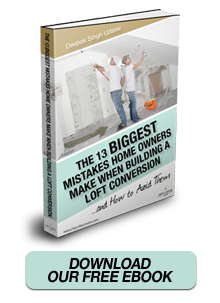Loft Conversions Increase The Value of Your Home
Phil Spencer of the hit TV show Location, Location, Location, says the easiest way to add value to your house is a loft conversion. There are a number of reasons for this; loft conversions are more cost-effective than other types of home extensions, give you the best ROI and are not disruptive to build.
There are also a number of reasons for home owners to convert dead space in the attic to living space with a view. But whatever your unique reasons are, the one thing all loft conversions have in common is they add value to your property.
A survey conducted by GE Money and over one hundred estate agents discovered loft conversions add an average of 12.5 per cent to the selling price of your home. Spend £20,000 on a loft conversion and you could add extra £40,000 to the value of your house.
Why build a loft conversion
Loft conversion can save you money from the outset. They are far less expensive than buying a new home or building a conservatory, and with the design technology and craftsmanship of skilled loft conversion specialists practically anything is possible. Whilst house prices are going through the roof, you can add value to your house in the roof.
There are some conditions that need to be met however. The attic room must qualify as a living space and not the classic attic room that is accessed through trap door by a step ladder. This is resolved by installing a staircase with a private access into the infrastructure of your home.
Furthermore, maintenance costs are kept to a minimum as the plumbing, heating and electric in a converted loft runs off the existing mains supply. Therefore, you do not need to install and maintain a new heating system.
Planning permission
If you are seriously contemplating adding a loft extension to your home, make sure you know and understand your legal requirements. A loft conversion is classed as permitted development meaning you are free to install a loft conversion without applying to your local council for permission.
However, loft conversions are still subject to restrictions so you should be familiar with the building regulation for the type of property you live in. For example, if you live in a terraced house you are permitted up to 40 cubic metres of additional attic space whereas semi-detached households can add up to 50 cubic metres.
You will find plenty of information about the building regulations for the type of home you live in with your local council, otherwise seek guidance from an architect or loft conversion specialist. Plans for your attic extension need to be submitted to the council to ensure they do not breach building regulations and that the structure of your home and new home is safe for you to live in.
Under the Party Wall Act 1933 you are also permitted to inform neighbours with whom you share a boundary of your intention to build a loft conversion. This is really a matter of formality and neighbourly trust, although it does protect you and your neighbour against fees for any damage caused to the property as a result of the extension and gives them the opportunity to say what hours of the day construction can take place.
Loft conversions can add value to your home if they are constructed properly – otherwise they can be very costly. And there are a lot of mistakes people can make that cause them to lose money rather than make a profit. For that reason alone, it is more cost-effective to seek the guidance of a loft conversion specialist.
City Lofts London – award-winning builders
02088988299
PS stuck for interiors inspiration? Look no further





